Thrombin
- Generic Name: thrombin topical bovine origin
- Brand Name: Thrombin-JMI
side effects drug center thrombin-jmi (thrombin topical bovine origin) drug
Drug Description
THROMBIN-JMI®
(thrombin, topical (bovine) Solution for topical use
WARNING
SEVERE BLEEDING AND THROMBOSIS COMPLICATIONS
- THROMBIN-JMI can cause fatal severe bleeding or thrombosis . Thrombos is may result from the development of antibodies against bovine thrombin. Bleeding may res ult from the development of antibodies against factor V. These may cross -react with human factor V and lead to its deficiency.
- Do not re-expose patients to THROMBIN-JMI if there are known or suspected antibodies to bovine thrombin and/or factor V.
- Monitor patients for abnormal coagulation laboratory values , bleeding, or thrombosis.
DESCRIPTION
THROMBIN-JMI, THROMBIN, Topical (Bovine), is a protein substance produced through a conversion reaction in which prothrombin of bovine origin is activated by tissue thromboplastin of bovine origin in the presence of calcium chloride. It is supplied as a sterile powder that has been freeze-dried in the final container. Also contained in the preparation are mannitol and sodium chloride. Mannitol is included to make the dried product friable and more readily soluble. The product contains no preservative.
THROMBIN-JMI has been chromatographically purified and further processed by ultrafiltration. Analytical studies demonstrate the current manufacturing process' capability to remove significant amounts of extraneous proteins, and result in a reduction of factor Va light chain content to levels below the limit of detection of semi-quantitative Western Blot assay (<92 ng/mL, when reconstituted as directed). The clinical significance of these findings is unknown.
Indications
THROMBIN-JMI is topical bovine thrombin indicated to aid hemostasis whenever oozing blood and minor bleeding from capillaries and small venules is accessible and control of bleeding by standard surgical techniques (such as suture, ligature, or cautery) is ineffective or impractical.
In various types of surgeries, solutions of THROMBIN-JMI may be used in conjunction with an Absorbable Gelatin Sponge, USP for hemostasis.
Dosage
DOSAGE AND ADMINISTRATION
For topical use on the surface of bleeding tissue only. Do not inject.
Reconstitution
- For routine use, reconstitute THROMBIN-JMI with sterile isotonic saline at a recommended concentration of 1,000 to 2,000 International Units per mL.
- Where bleeding is profuse, as from abraded surfaces of liver or spleen, concentrations of 1,000 International Units per mL may be required.
- For general use in plastic surgery, dental extractions, skin grafting, etc. solutions containing approximately 100 International Units per mL are frequently used. Prepare intermediate strengths to suit the needs of the case by diluting the contents of the THROMBIN-JMI container with an appropriate volume of sterile isotonic saline. THROMBIN-JMI can be used in a dry form on oozing surfaces.
- In instances where a concentration of approximately 1,000 units per mL is desired, the contents of the vial of sterile isotonic saline diluent may be transferred into the THROMBIN-JMI container with a sterile syringe or sterile transfer device.
If the transfer device is used for reconstitution, transfer the diluent in the following manner:
- Remove the plastic cap off of the diluent vial.
- Remove the Tyvek cover from the transfer device container. Do not remove the device from the package.
- Seat the blue end of the device on the diluent vial, pushing down until the spike penetrates the diaphragm and the device snaps in place.
- Flip the plastic cover off on the THROMBIN-JMI container. DO NOT REMOVE THE ALUMINUM SEAL.
- Remove the plastic package from the transfer device. Do not touch the exposed end of the device.
- Invert the vial of diluent and insert the clear end of the transfer device into the diaphragm of the THROMBIN-JMI container.
 |
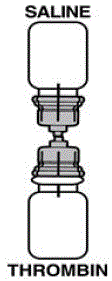 |
CAUTION: Solutions should be used promptly upon removal from the container. However, the solution may be refrigerated at 2°C – 8°C for up to 24 hours, or may be stored at room temperature for up to 8 hours after reconstitution.
THROMBIN-JMI Pump Spray Kit
Refer to THROMBIN-JMI Pump Spray Kit instructions for spray pump assembly and use.
Each spray kit contains one vial of THROMBIN-JMI, one vial of diluent and one spray pump and actuator.
- Remove the outer lid by pulling up at the indicated edge. The inner tray is sterile and suitable for introduction into any operating field.
- Remove the cover on inner tray to expose sterile contents.
- Reconstitute the THROMBIN-JMI to desired potency by introducing sterile isotonic saline with a sterile syringe or a sterile transfer device. If the transfer device is used, follow the previously described procedure.
- When the THROMBIN-JMI is completely dissolved, open vial by flipping up metal and tearing counterclockwise.
- Remove the rubber diaphragm from vial. Remove pump with protective cap from tray and snap onto vial.
- Remove protective cap and attach actuator.
- To spray, hold vial upright or at a slight angle. Several strokes of the pump will be required to expel the solution.
- Discard unused contents and pump: DO NOT TRANSFER SPRAY PUMP TO ANOTHER VIAL.
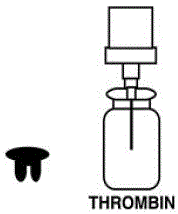 |
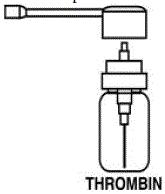 |
THROMBIN-JMI Syringe Spray Kit
Refer to THROMBIN-JMI Syringe Spray Kit instructions for spray syringe assembly and use. Each syringe kit contains one vial of THROMBIN-JMI, one vial of diluent and one spray tip and syringe.
- Remove the outer lid by pulling up at the indicated edge. The inner tray is sterile and suitable for introduction into any operating field.
- Remove the cover on the inner tray to expose sterile contents.
- Using the sterile syringe equipped with a transfer device, draw the desired amount of saline diluent from the vial into the syringe.
- Inject the saline diluent into the THROMBIN-JMI thrombin vial from the syringe to reconstitute the THROMBIN-JMI thrombin powder.
- When the THROMBIN-JMI powder is completely dissolved, draw the THROMBIN-JMI THROMBIN solution into the syringe.
- Remove the syringe from the transfer device by turning syringe counterclockwise.
- Affix spray tip by pushing down and turning clockwise until the spray tip locks in place.
- To spray, depress the syringe plunger in a normal fashion to dispense the THROMBIN-JMI THROMBIN solution through the tip in a fine spray.
- Discard unused contents and syringe.
 |
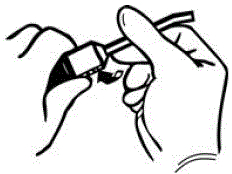 |
THROMBIN-JMI Epistaxis Kit
Refer to THROMBIN-JMI Epistaxis Kit instructions for accessory assembly and use.
Each epistaxis kit contains one vial of THROMBIN-JMI, one vial of diluent and one nasal drug delivery device.
- Remove the outer lid by pulling up at the indicated edge. The inner tray is sterile and suitable for introduction into any operating field.
- Remove the cover on the inner tray to expose sterile contents.
- Using the sterile syringe equipped with a transfer device, draw the desired amount of saline diluent from the vial into the syringe.
- Inject the saline diluent into the THROMBIN-JMI thrombin vial from the syringe to reconstitute the THROMBIN-JMI thrombin powder.
- When the THROMBIN-JMI powder is completely dissolved, draw the THROMBIN-JMI THROMBIN solution into the syringe.
- Remove the syringe from the transfer device by turning syringe counterclockwise.
- Affix the nasal drug delivery device on to the syringe by pushing the device down onto the THROMBIN-JMI thrombin solution filled syringe and turn clockwise until the nasal drug delivery device locks in place.
- Insert the nasal drug delivery device into the naris and spray the THROMBIN-JMI thrombin solution onto the nasal mucosa through the nasal drug delivery device by depressing the syringe plunger using mild or moderate pressure on the syringe plunger.
- After administration of THROMBIN-JMI, the device may be removed immediately or briefly held in the nasal passage.
- Discard the unused contents, nasal drug delivery device, and the syringe.
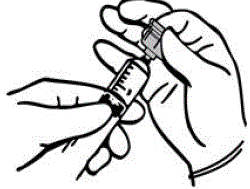 |
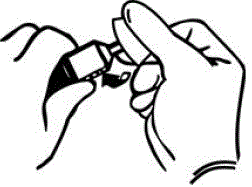 |
Administration
Topical Application Of THROMBIN-JMI
- The recipient surface should be sponged (not wiped) free of blood before THROMBIN-JMI is applied.
- A spray may be used or the surface may be flooded using a sterile syringe and small gauge needle. The most effective hemostasis results occur when the THROMBIN-JMI mixes freely with the blood as soon as it reaches the surface.
- Sponging of the treated surfaces should be avoided to assure that the clot remains securely in place.
Use In Conjunction With Absorbable Gelatin Sponge
Consult the Absorbable Gelatin Sponge, USP labeling for complete information for use prior to utilizing the following thrombin saturated sponge procedure.
- Prepare THROMBIN-JMI solution to desired strength.
- Immerse sponge strips of the desired size in THROMBIN-JMI solution. Knead the sponge strips vigorously with moistened, gloved fingers to remove trapped air, thereby facilitating saturation of the sponge.
- Apply saturated sponge to bleeding area. Hold in place with a pledget of cotton or a small gauze sponge until hemostasis occurs.
Use In Conjunction With FloSeal™ NT
THROMBIN-JMI may also be used with FloSeal™ NT according to the directions for use in the FloSeal™ NT package insert.
HOW SUPPLIED
Dosage Forms And Strengths
THROMBIN-JMI (THROMBIN, Topical (Bovine) U.S.P.), Solution for topical use is supplied in the following packages:
Vial: 5,000 IU vial with 5 mL diluent.
Vial: 20,000 IU vial with 20 mL diluent.
THROMBIN-JMI Pump Spray Kit is supplied in the following packages:
Pump Spray Kit: 20,000 IU vial with 20 mL diluent, spray pump and actuator.
THROMBIN-JMI Syringe Spray Kit is supplied in the following packages:
Syringe Spray Kit: 5,000 IU vial with 5 mL diluent, spray tip and syringe.
Syringe Spray Kit: 20,000 IU vial with 20 mL diluent, spray tip and syringe.
THROMBIN-JMI Epistaxis Kit is supplied in the following packages:
5,000 IU vial with 5 mL diluent, nasal drug delivery device and syringe.
THROMBIN-JMI® is supplied in the Gelfoam-JMI™ Kits:
Gelfoam-JMI™ Sponge Kit (Gelfoam® Absorbable Gelatin Sponge, USP and THROMBIN, Topical (Bovine) U.S.P., THROMBIN-JMI® , 5,000 IU vial with 5 mL diluent).
Gelfoam-JMI™ Powder Kit (Gelfoam® Absorbable Gelatin Powder and THROMBIN, Topical (Bovine) U.S.P., THROMBIN-JMI® , 5,000 IU with 5 mL diluent).
Storage And Handling
Not made with natural rubber latex.
THROMBIN-JMI® is supplied in the following packages:
NDC 60793-215-05
Vial: 5,000 IU vial with 5 mL diluent.
NDC 60793-217-20
Vial: 20,000 IU vial with 20 mL diluent.
THROMBIN-JMI® Pump Spray Kit is supplied in the following package:
NDC 60793-217-21
Pump Spray Kit: 20,000 IU vial with 20 mL diluent, spray pump and actuator.
THROMBIN-JMI® Syringe Spray Kit is supplied in the following packages:
NDC 60793-705-05
Syringe Spray Kit: 5,000 IU vial with 5 mL diluent, spray tip and syringe.
NDC 60793-217-22
Syringe Spray Kit: 20,000 IU vial with 20 mL diluent, spray tip and syringe.
THROMBIN-JMI® Epistaxis Kit is supplied in the following package:
NDC 60793-205-05
Epistaxis Kit: 5,000 IU vial with 5 mL diluent, nasal drug delivery device and syringe.
THROMBIN-JMI® is supplied in the Gelfoam-JMI™ Kits:
GTIN 00360793310107 (60793-310-10)
Gelfoam-JMI™ Sponge Kit (Gelfoam® Absorbable Gelatin Sponge, USP and THROMBIN, Topical
(Bovine) U.S.P., THROMBIN-JMI® , 5,000 IU vial with 5 mL diluent).
GTIN 00360793410104 (60793-410-10)
Gelfoam-JMI™ Powder Kit (Gelfoam® Absorbable Gelatin Powder and THROMBIN, Topical
(Bovine) U.S.P., THROMBIN-JMI® , 5,000 IU with 5 mL diluent).
Store THROMBIN-JMI® at 2°C – 25°C (36°F – 77°F).
Manufactured by: GenTrac, Incorporated, Middleton, Wisconsin 53562. Revised: Aug 2017.
Side Effects & Drug Interactions
SIDE EFFECTS
The most common adverse reactions (incidence greater than or equal to 2%) following administration of THROMBIN-JMI were: hypersensitivity, bleeding, anemia, post-operative wound infection, thromboembolic events, hypotension, pyrexia, tachycardia and thrombocytopenia.
Clinical Trials Experience
Because clinical trials are conducted under widely varying conditions, adverse reaction rates observed in the clinical trials of a drug cannot be directly compared to rates in the clinical trials of another drug and may not reflect the rates observed in practice.
The safety assessment of THROMBIN-JMI is based primarily on the review of post marketing experience including three (3) randomized controlled clinical trials in which THROMBIN-JMI was used as a comparator and one (1) observational study. In these studies, the most common adverse reactions (incidence greater than or equal to 2%) following administration of THROMBIN-JMI were: hypersensitivity, bleeding, anemia, post-operative wound infection, thromboembolic events, hypotension, pyrexia, tachycardia and thrombocytopenia [see Clinical Studies].
Postmarketing Experience
The following serious adverse reactions have been identified during post approval use of THROMBIN-JMI: anaphylactic reactions, prolonged prothrombin time, prolonged activated partial thromboplastin time, disseminated intravascular coagulation, factor V deficiency, post-procedural hematoma, swelling and Staphylococcal wound infection. Because these reactions are reported voluntarily from a population of uncertain size, it is not always possible to reliably estimate their frequency or establish a causal relationship to drug exposure.
DRUG INTERACTIONS
No Information Provided
Warnings & Precautions
WARNINGS
Included as part of the "PRECAUTIONS" Section
PRECAUTIONS
Warning: Severe Bleeding and Thrombos is Complications
Hypersensitivity Reactions
- Allergic reactions, including anaphylactic/anaphylactoid reactions, have been reported following administration of THROMBIN-JMI.
- Institute intensive supportive measures and treat individual symptoms. Secure the airway and establish adequate respiratory exchange.
Thrombosis
THROMBIN-JMI causes thrombosis if it enters the circulatory system. Apply topically. DO NOT INJECT.
Immunogenicity
Inhibitory antibodies may develop in patients and interfere with hemostasis. Monitor patients for abnormal coagulation laboratory values, bleeding, or thrombosis.
Use In Specific Populations
Pregnancy
Animal reproduction studies have not been conducted with THROMBIN-JMI. It is also not known whether THROMBIN-JMI can cause fetal harm when administered to a pregnant woman or can affect reproduction capacity. THROMBIN-JMI should be given to a pregnant woman only if clearly needed.
Labor And Delivery
Information is unknown.
Nursing Mothers
It is not known whether this drug is excreted in human milk. Because many drugs are excreted in human milk, caution should be exercised when THROMBIN-JMI is administered to a nursing woman.
Pediatric Use
Safety and effectiveness in children have not been established
Geriatric Use
Clinical studies of THROMBIN-JMI did not include sufficient numbers of subjects aged 65 and over to determine whether they respond differently from younger subjects. Other reported clinical experience has not identified differences in responses between the elderly and younger patients. In general, dose selection for an elderly patient should be cautious, usually starting at the low end of the dosing range, reflecting the greater frequency of decreased hepatic, renal, or cardiac function, and of concomitant disease or other drug therapy.
Overdosage & Contraindications
OVERDOSE
No Information Provided
CONTRAINDICATIONS
- Do not inject directly into the circulatory system. Because of its action in the clotting mechanism, THROMBIN-JMI can cause extensive intravascular clotting or death.
- Do not re-expose patients to THROMBIN-JMI if there are known or suspected antibodies to bovine thrombin and/or factor V.
- Do not administer to patients with a history of hypersensitivity to THROMBIN-JMI, its components and/or to material of bovine origin.
- Do not use for treatment of severe or brisk arterial bleeding.
Clinical Pharmacology
Mechanism Of Action
THROMBIN-JMI requires no intermediate physiological agent for its action. It activates platelets and catalyzes the conversion of fibrinogen to fibrin, which are essential steps for clot formation. Failure to clot blood occurs in the case where the primary clotting defect is the absence of fibrinogen itself. The speed with which thrombin clots blood is dependent upon the concentration of both thrombin and fibrinogen.
Clinical Studies
In a randomized, double-blinded, controlled trial that compared recombinant human thrombin to THROMBIN-JMI, 206 patients received THROMBIN-JMI and 205 patients received recombinant human thrombin as adjuncts to hemostasis in liver resection, spine, peripheral arterial bypass, and dialysis access surgeries. Four hundred one (401) patients completed the trial. The reported adverse reactions in both treatment groups were: cardiac events (18%), hypersensitivity (17%), other infections (15%), bleeding (11%), postoperative wound infection (10%) and thromboembolic events (5%). Among 200 patients who were evaluated for the presence of antibodies to THROMBIN-JMI, 10 patient (5%) were positive at baseline and 43 (21.5%) after treatment. The seroconversion rate in THROMBIN-JMI group was 18.4%.
In another multicenter, prospective, randomized, double-blinded, controlled trial that compared plasmaderived human thrombin to THROMBIN-JMI, 152 patients received THROMBIN-JMI and 153 patients received human thrombin applied topically to the target bleeding site with a gelatin sponge. Serious adverse reactions (pyrexia and post-procedural hematoma) were reported in two patients receiving THROMBIN-JMI. In this study, 16 out of 126 (12.7%) patients who received THROMBIN-JMI demonstrated seroconversion for at least one of the four antibodies assayed. The four separate ELISA assays used to detect development of antibodies and the corresponding antibody development rates included: 1) Anti-bovine thrombin 10/126 (7.94%), 2) Anti-bovine factor V/Va 12/126 (9.52%), 3) Antihuman thrombin 3/126 (2.38%) and 4) Anti-human factor V/Va 0/126 (0%).The effect of repeat exposure was evaluated in a third multi-center, prospective, randomized, double-blinded, controlled trial on 72 patients with diabetic foot ulcers, using a gel prepared with THROMBIN-JMI and autologous platelet rich plasma that was applied weekly for 12 weeks. Forty (40) patients were treated with the gel at fourteen (14) sites. Safety parameters were evaluated during the 12 weeks of treatment and the three month follow-up period. No serious adverse reactions related to the gel treatment were reported.
A total of 554 subjects were enrolled, in a multi-center, open-label, observational study (MOSAIC) conducted to assess the effect of possible exposure to THROMBIN-JMI on activated partial thromboplastin time (aPTT) at 48 hours post-surgery in subjects with likelihood of prior exposure to THROMBIN-JMI within the past 4 years. Of the 554 subjects, 550 had undergone surgery and completed the study. A total of 384 subjects undergoing vascular surgeries, neurosurgeries and orthopedic surgeries were exposed to THROMBIN-JMI (5,000 international units to 20,000 international units).
In this study, the impact of exposure to THROMBIN-JMI in 78 subjects who were positive for antibovine thrombin (aBT) antibodies prior to surgery was compared with 140 subjects who did not have any aBT antibodies and were not exposed to THROMBIN-JMI. The study did not meet the prespecified primary endpoint, a mean change from baseline in aPTT at 48 hours post-surgery. The study was not powered to detect coagulopathy related to an immune response after bovine thrombin use.
A post hoc analysis was performed in which subjects who underwent surgery were re-assigned to one of four exploratory cohorts based on the presence or absence of pre-surgery anti-bovine factor V/antibovine factor V active (aBV/Va) antibodies and whether or not they were administered THROMBINJMI during the study surgery. Non-inferiority (based on aPTT) was observed in these exploratory cohorts at all-time points of 48 hours, 4 weeks and 8 weeks post-surgery.
For the primary study cohort (THROMBIN-JMI use in subjects with baseline positive aBT or positive aBV/Va), there was a higher incidence of seroconversion from anti human thrombin (aHT) negative at baseline to post-surgery positive compared to the primary reference cohort (no THROMBIN-JMI use in subjects with baseline negative aBT or negative aBV/Va). This difference was not present at 48 hours after surgery but was evident at 4 weeks and 8 weeks post-surgery. A similar immunological response with aBT and aBV/Va antibodies was observed following THROMBIN-JMI administration.
Secondary immune responses in patients treated with THROMBIN-JMI were evidenced by the generation of anti-bovine and anti-human thrombin and factor V/Va antibodies, consistent with known immunogenicity of topical bovine thrombin.
Medication Guide
PATIENT INFORMATION
Because THROMBIN-JMI may cause the formation of clots in blood vessels if absorbed systemically, advise patients to consult their physician if they experience leg tenderness or swelling, chest pain, shortness of breath, or difficulty speaking or swallowing.




